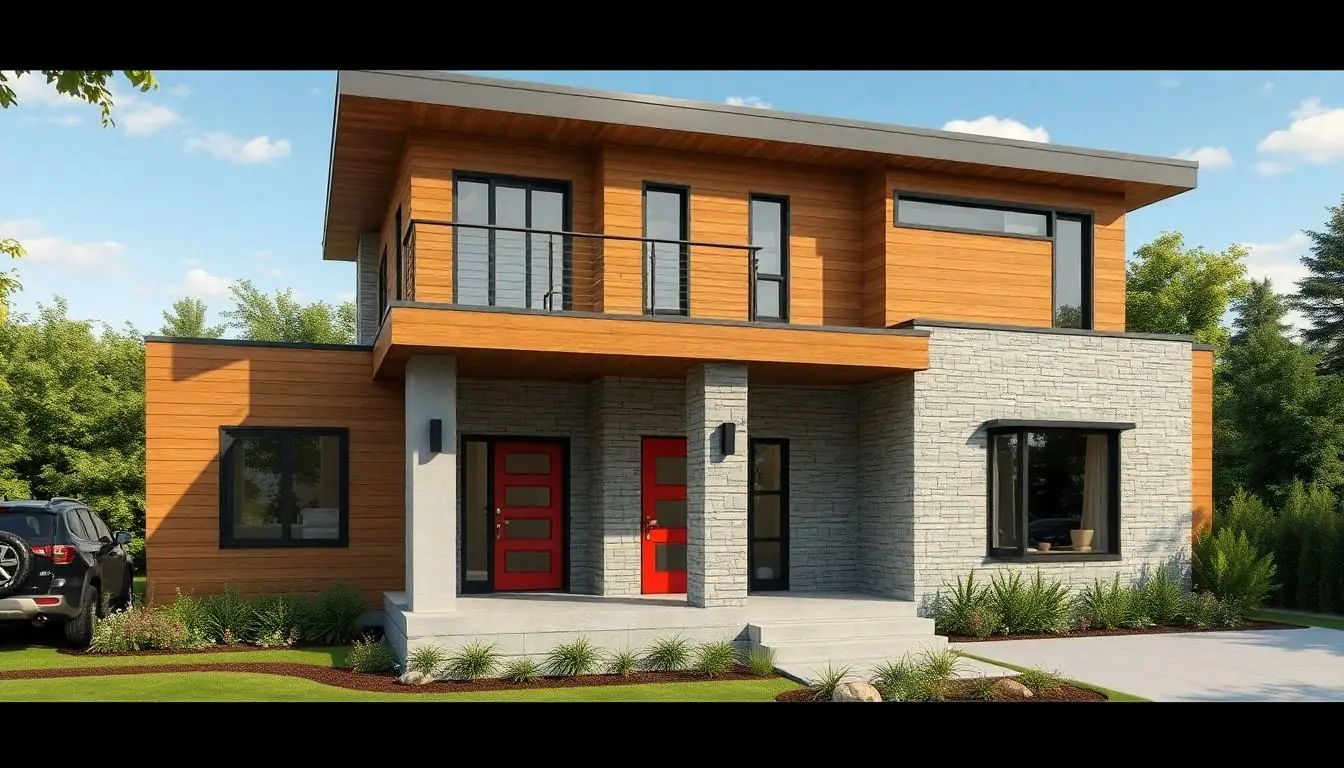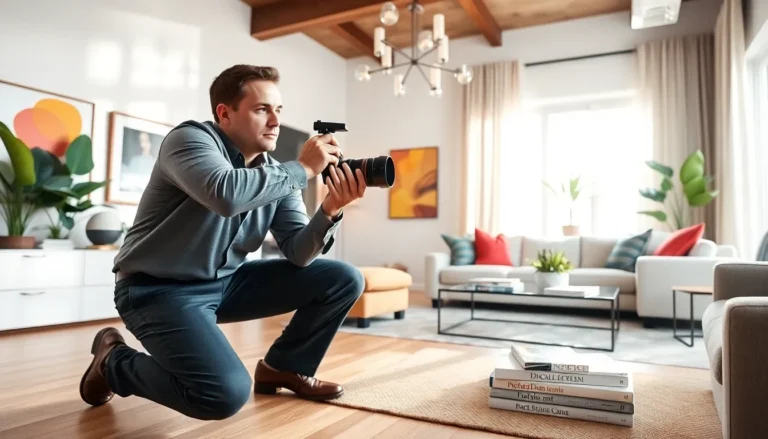In a world where first impressions matter, the exterior of a house is like the outfit you wear to a job interview—it’s gotta look sharp. Modern house exterior design isn’t just about slapping on a fresh coat of paint; it’s an art form that combines style, functionality, and a sprinkle of personality. Imagine walking up to a home that’s a stunning blend of sleek lines, bold colors, and eco-friendly materials. It’s like your favorite superhero, but for houses!
Table of Contents
ToggleWhat Is Modern House Exterior Design?
Modern house exterior design emphasizes clean lines, minimalist aesthetics, and innovative materials. This concept prioritizes a seamless connection between indoor and outdoor spaces. Characteristics of modern designs often include large windows that enhance natural light and promote energy efficiency. Utilizing eco-friendly materials not only supports sustainability but also adds a distinctive flair.
Color palettes in modern exteriors lean toward neutral tones, accented by bold hues for dramatic visual impact. Textures play a crucial role, often integrating elements like wood, stone, or metal to create visual interest. Architectural features may include cantilevered roofs, geometric shapes, and open layouts that redefine traditional norms of home design.
Landscaping complements these designs, featuring native plants and hardscaping elements that enhance the overall aesthetic. Outdoor living spaces, such as patios and decks, contribute to a lifestyle that embraces nature. Innovation in building techniques leads to unique structures that serve both functional and aesthetic purposes.
Investing in modern house exterior design offers long-term benefits. Homeowners enjoy increased curb appeal and potential property value while reflecting their personal style. In summary, modern house exterior design encapsulates a forward-thinking approach that harmonizes visuals with functionality.
Key Elements of Modern House Exterior Design

Modern house exterior design combines aesthetics with functionality. It incorporates elements that create a striking visual impact while enhancing everyday living.
Materials and Textures
Wood, stone, and metal are popular materials in modern designs. Each brings unique textures that add depth to the overall appearance. Stone cladding provides durability alongside a rustic look, enhancing character. Wood accents often create warmth, offering a cozy contrast to sleek surfaces. Metal elements, like steel or aluminum, contribute to a contemporary feel and are often used for railings or roofing. Mixing these materials achieves a sophisticated look and maintains structural integrity in various environmental conditions.
Color Schemes
Neutral palettes dominate modern exteriors, with shades of gray, white, and beige setting the foundation. Bold colors, such as deep blues or vibrant reds, serve as striking accents. Accentuating doors or window frames with color accentuates architectural features. Using monochromatic schemes strengthens visual coherence, while strategic splashes of color create an inviting feel. Color combinations often reflect personal style while grounding the design in contemporary trends.
Architectural Styles
Geometric shapes define modern architectural styles, presenting sharp lines and unconventional structures. Flat roofs and cantilevered designs provide a unique silhouette against the landscape. Open floor plans often blend the indoor and outdoor experience seamlessly, inviting nature into the living space. Various roof styles create visual interest while maximizing natural light. These architectural choices emphasize functionality, ensuring homes are equipped for modern lifestyles.
Trends in Modern House Exterior Design
Modern house exterior design continually evolves, responding to aesthetic and functional demands. Trends focus on sustainability and technology, enhancing both beauty and efficiency.
Sustainable Design Practices
Sustainable design practices play a crucial role in modern exteriors. Homeowners prioritize materials like recycled wood and eco-friendly concrete, which minimize environmental impact. Energy-efficient windows and roofs reduce heating and cooling costs. Incorporating native plants in landscaping promotes biodiversity while requiring less maintenance. Integrating solar panels not only powers homes but also lowers utility bills. Rainwater harvesting systems capture runoff for irrigation, promoting water conservation. These practices ensure that modern designs reflect a commitment to sustainability.
Incorporating Technology
Incorporating technology transforms modern exteriors into smart spaces. Home automation systems control lighting, climate, and security, enhancing comfort and safety. Smart irrigation systems adjust based on weather conditions, saving water. Innovative building materials like reflective glass contribute to energy efficiency, reducing heat gain. Exterior lighting systems can be programmed for energy savings and aesthetic appeal. Drones and VR technology assist in design planning and visualization, streamlining the construction process. These technological advancements elevate the functionality and appeal of modern house designs.
Popular Modern House Exterior Design Examples
Sleek mid-century modern homes often feature flat roofs and large glass windows, providing a seamless connection to the outdoors. Clean lines define contemporary structures, incorporating materials such as steel and wood for a minimalist impact. Bold color accents contrast with neutral palettes, creating striking visual appeal on facades.
Asymmetrical designs stand out among popular styles, breaking traditional norms. Subtle landscaping with native plants complements these structures, enhancing the overall aesthetic while promoting sustainability. Cantilevered roofs add depth and intrigue, often creating shaded outdoor areas for relaxation.
Eco-friendly features attract attention in modern designs. Homes equipped with solar panels and rainwater harvesting systems reflect an embrace of technology and environmental responsibility. Textured surfaces such as stone or ceramic tiles bring unique character, ensuring no two homes appear identical.
Innovative architectural features, like geometric shapes, create a distinctive identity. Luxury properties increasingly incorporate outdoor living spaces, such as patios and decks, that extend functionality beyond the interior. Use of large sliding doors promotes natural light and views, emphasizing the connection to nature.
In urban settings, modern designs often incorporate vertical gardens or balconies adorned with greenery, merging aesthetics with ecological benefits. Open floor plans further blur boundaries between indoor and outdoor spaces, maximizing usability. These examples illustrate that modern house exteriors prioritize functionality, sustainability, and individuality, showcasing a forward-thinking approach to residential design.
Modern house exterior design transcends traditional aesthetics by blending style and functionality. This approach not only enhances curb appeal but also reflects the homeowner’s unique personality. As sustainability and technology continue to shape the industry, embracing these elements can lead to a more eco-friendly and efficient living space.
Investing in a thoughtfully designed exterior can elevate a home’s value and create an inviting atmosphere. With innovative materials and contemporary architectural features, modern homes stand out as symbols of progress and creativity. Ultimately, a well-designed exterior serves as a powerful statement about a homeowner’s commitment to both beauty and practicality.



